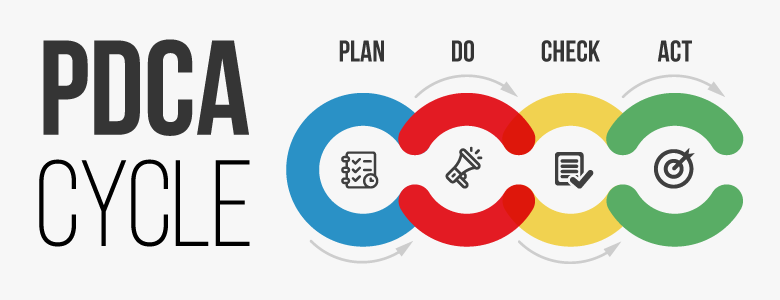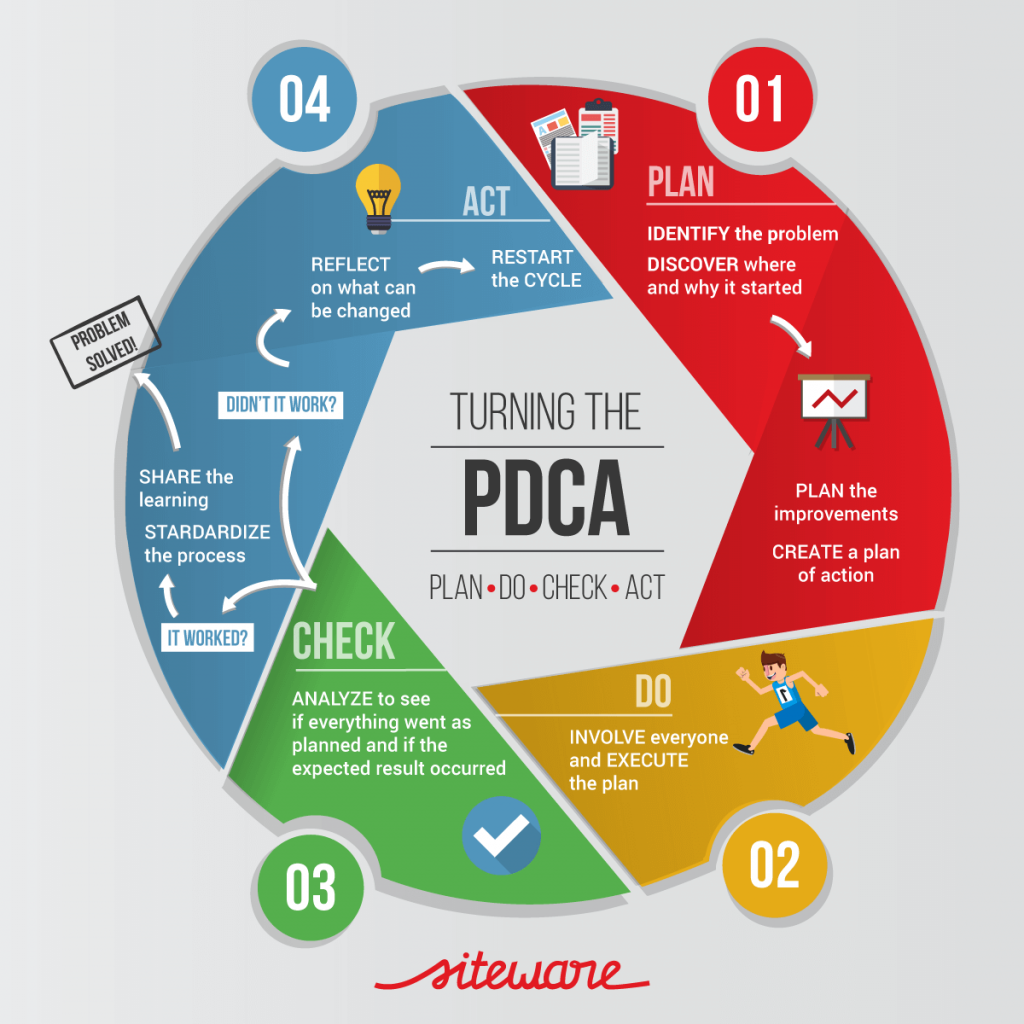
Here on the blog we talked about some of the most used methods to improve management, such as FCA and OKR. This time, we have chosen to talk about a well-known methodology used for process improvement and problem solving: the PDCA Cycle.
But what is the PDCA cycle? Do you really know?
A complete and efficient tool, PDCA (Plan Do Check Act) is one of the most well-known and used methods for developing strategic planning efficiently in companies.
The quality of the services offered by companies is, increasingly, a necessary differential for success and prominence. For this, the effectiveness of the processes is shown as a determining factor in the development of the business.
Before constructing a PDCA Cycle, it is important to know that this methodology is intended to help execute the strategy. Therefore, the strategy must be previously developed, with a prepared and conscious team.
In this way, the management objectives can not only leave the paper, but also have their process monitored so that they do not get lost along the way. Understanding what the PDCA Cycle is and using it in an organizational environment is a possible way to improve results and leverage company performance.
In this article, we explain from the origin of the methodology to its simple and efficient practical application. Let’s go!
The PDCA Cycle is also called the Shewhart or Deming Cycle, names that attribute credit to its creators. Engineer Walter Shewhart was the creator of the method in the 1920s, but the model was to become famous only in the 1950s, especially in Japan, thanks to American professor
William Deming, who is considered the father of quality control in production processes.
Its creators were inspired mainly by the Americans Clarence Irving Lewis and John Dewey, who were two of the founders of the philosophical school of pragmatism, as well as several other philosophers who wrote about the generation of knowledge.
Dewey reflected on the five-step problem-solving solution, which was essential to the creation of the PDCA Cycle as we know it today:
1. Understand the difficulty
2. Locate the problem
3. Define the problem
4. Suggest possible solutions and develop the reasoning for the suggested influences
5. Afterwards, observe the applied solutions, which leads to their acceptance or rejection
Initially, the PDCA cycle was developed to be applied in the administration of quality management, being a recommended method for the continuous improvement of quality, but its use was improved and today PDCA is one of the main tools for the understanding of the administrative process and for problem solving.
The method underwent several changes during its more than 90 years of existence and can be adapted to be used in any type of company, regardless of its size or focus.
The PDCA Cycle is a methodology used for continuous process improvement and problem solving in companies. This method is used to troubleshoot problems that are not easily viewed. Generally, these problems have also undergone several failed attempts at solution. Its purpose is to accelerate and perfect the activities of a company, by identifying the problems, their causes and possible solutions.
It is an iterative method. You must be wondering: what is this? It is simple.
It is a type of process that, with each repetition, comes to a different result. These results, in turn, will be used cumulatively in subsequent times. In this way, it can be said that PDCA is a cycle that brings different and complementary results to each use, which makes it a continuous use method for greater success in solving problems.
But why is it important? Because it makes it possible to identify faults, which makes the repair process simpler. In addition, the PDCA Cycle prioritizes measurement, an important factor in management. It is essential to measure your results statistically, with concrete data, to be able to manage and repeat the best processes or avoid those that do not generate results. It can be used both as a method for deploying new ideas and for solving problems. PDCA can be deployed at all levels of an organization, from the board to the operation floor.
The acronym PDCA stands for Plan, Do, Check, Act. These are the 4 steps of the cycle, which usually begins with Planning. There is the possibility of using variations, depending on the type of objective sought by the company.

The logical order begins with PLANNING, which focuses on the strategic part. The purpose here is to raise and analyze information to set objectives and goals.
It is important to devise a plan / strategy that solves the problems encountered, developing them based on the company’s political values and guidelines, then taking into account the establishment of the intended objectives with the cycle, the choice of the path to be traveled so that the objectives are achieved and the definition of the methods that will be used to achieve this. In addition to these phases, in planning the team that will be part of the process, including a leader for each phase, is chosen.
It is divided into 4 parts, which are:
At this stage, it is important to define the problem and recognize its importance for the development of the activity. Ask yourself “What’s happening?”, consider the history of the problem, show the losses caused by the problem, and propose a date for the problem to be resolved. To get a better view of the problem, you can use reports, data, photos or tools like Brainstorming or 5W2H.
In this phase, the problem must be observed in its details, with its specific characteristics. This may be the most time-consuming phase of the process, as the characteristics of the problem must be analyzed from various points of view, and the problem must be observed wherever it occurs.
After this analysis, a solution timetable for this problem, an estimate of the budget available to solve the problem, as well as a definition of the goal to be reached by the team must all be decided for the problem’s solution.
The question to ask is “Why is this problem happening?” It is at this stage that the causes will be discovered. Raising the possible causes, placing them in order of relevancy and choosing the most probable, besides testing these hypotheses with new data collected and discarding the most unlikely are part of the selection of causes of the problem. Here you can use, for example, Brainstorming or the Cause and Effect Diagram.
Once you have identified the causes of the problem, it is time to create actions to eradicate them. For this, it is necessary to identify possible solutions and divide the participation of the team in the development of this action plan. Once you’ve worked out the plan, it’s time to consider the costs of the actions and define what resources will be needed.
In the DO phase of the PDCA Cycle, everything that was analyzed by Planning is put into practice. It is important that the plan has been created carefully and in detail so that there are no shortcomings in the rest of the process. The DO phase is the execution of the plan, and it is also where the team is trained for the method to work.
It is one of the most important parts of the cycle and should be closely monitored so that there is no failure in the selected method. It is important to note all the results (good or bad) and the date when they occurred, in addition to communicating and training the selected employees for the actions and their deadlines, and training techniques to be used.
In the CHECK phase, it is where the analysis of what was performed happens. That is, it is the phase in which the verification of the results obtained with the chosen action plan occurs. This phase can be developed during the whole cycle of the plan, since it is used to verify the work (if it is being executed correctly) and also to check its results (by statistically verifying the data, like failures and errors.)
It is important to verify that what has been planned is already being implemented, in addition to comparing the results between before and after and the development of the achievement of the proposed goal. If the results obtained in the verification are not satisfactory, it is recommended that you return to the Planning phase, in the Observation of the Problem.
Finally, in the ACT phase, corrective actions are taken to solve the problems that were verified during the process. Here we correct the failures found in the previous process so that their causes are investigated, preventing them from occurring again. Once you have solved these faults, the process should start over. The PDCA Cycle should always be resumed, for the constant improvement of processes and practices.
This phase is divided into 2 parts:
Here the things that went right in the plan of action are standardized, so that the problem does not risk reappearing. This standardization can be done in a new standards document, or in the modification of existing documents. In addition, it is important to communicate changes via the company’s various communication channels, such as e-mails, meetings, etc. For this standardization to be effective, the team must be able to develop it, which demands training and education for those involved in the change, which needs to be followed by constant monitoring and verification.
This is where the final evaluation of the team’s performance is made, analyzing all the results (with the help of graphs, like the Pareto Chart or the Check Sheet). Analyze what went right and what did not, find out what is needed to further improve the performance of the process, check if part of the problem remained, record the learning that the cycle generated for the group and think about future plans.
To better visualize the results obtained with the Plan Do Check Act Cycle, it is recommended to use the Pareto Chart, the 5W2H or the Check Sheet.
Now that you can answer the question: “what is the PDCA Cycle?”, it’s time to share it in your company.
This methodology is considered one of the simplest and most effective methodologies among the current quality management tools.
Using this method in a preventive and continuous way, it aids in the identification of possible improvements in the processes, avoids impulsive decisions made by the team and resource wastes, in addition to prioritizing the measurement of data and results essential for good management.
In order for these benefits to emerge with their use, it is essential that the employees involved in the process take care when building the team responsible for developing the PDCA, providing adequate training so that the methods used are in everyone’s hands for the steps to be successful.
Lastly, the Plan Do Check Act cycle needs to be a continuous process!
Its phases must be in constant development and should not be abandoned. When one cycle is over, another should start. Only in this way will process and activity improvements be cumulative and visible to the entire organization.
Now that you can answer the question “ what is the PDCA Cycle?”, it’s time to apply it in your business to obtain the best results!
STRATWs One is enterprise performance management software that can bring your people, operations and strategy together for better results. With it you can easily track various indicators in your business.
Revolutionize the management of your company with STRATWs One
Your technology partner to connect you to what really matters.